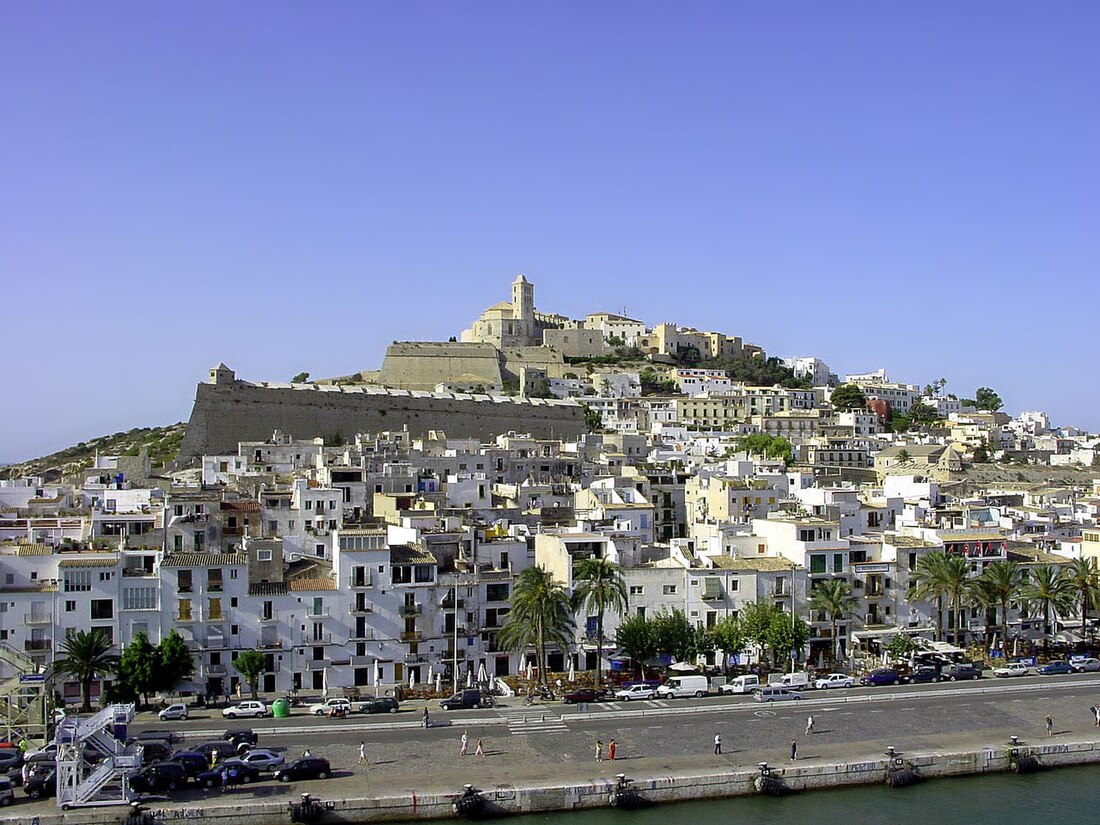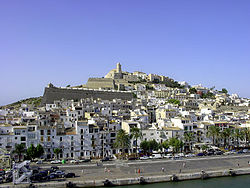Top Qs
Timeline
Chat
Perspective
Ibiza (city)
Municipality in Balearic Islands, Spain From Wikipedia, the free encyclopedia
Remove ads
Ibiza (Spanish: [iˈβiθa]; Catalan: Eivissa [əjˈvisə], commonly also Vila d'Eivissa [ˈvilə ðəjˈvisə] or simply Vila [ˈvilə]) is a city and municipality located on the southeast coast of the island of Ibiza in the Balearic Islands autonomous community.
The city is commonly divided into two parts: the old town, located on a fortified hilltop and called the Dalt Vila (literally "Upper Town")[2] and the more modern part, called the Eixample ("Extension").[3]
Sights in the city include the cathedral of Santa Maria d'Eivissa, located at the top of the Dalt Vila, and the Punic necropolis of Puig des Molins.[4] Nearby is the Sagrat Cor de Jesus monument, a 23-metre-high (75 ft) statue inspired by Christ the Redeemer, which is 3.1 miles (5.0 km) north of the city.[5]
Remove ads
History
Summarize
Perspective
The first inhabitants of the area were Phoenicians and Aiboshim is claimed to have been founded in 654 BC. The city had a population of 3,000 to 4,000 by the 5th century BC. The city was incorporated into the Roman Republic as a federated city until Emperor Vespasian turned it into Municipius Flavius Ebusus in 70 AD. The area was conquered by the Vandals in 424, and by the Byzantine Empire in 535.[6]
The area was incorporated into Al-Andalus in the 10th century and a new irrigation system was developed during this period. During the reign of King James I of Aragon the island was conquered by Guillem de Montgrí in August 1235. King James II of Aragon established a local government in 1299, and this lasted until 1717. The city was attacked by Peter of Castile during a war between Castile and Aragon in 1354.[6]
King Philip V of Spain issued the Decree of New Planta in 1715, which introduced the town hall government. The town was granted the title of city by King Charles III of Spain in 1782. The title of city was required for the creation of the Roman Catholic Diocese of Ibiza in 1782; Manuel Abad y Lasierra was its first bishop.[6][7]
UNESCO declared the city a World Heritage Site on 4 December 1999.[8]
Remove ads
Population
The city has a population of 50,643 (2021).[9]
Tourism

Ibiza is widely known and visited for its exciting nightlife. Some of the island's most notable nightclubs include Pacha, Amnesia, Space, and Ushuaïa. These four nightclubs are regularly in the top three of DJ Magazine's annual top 100 global clubs' chart.[10]
Climate
Summarize
Perspective
Between 1981 and 2010, the month with the highest average temperature was August at 26.3 °C (79 °F) and the month with the lowest was January at 11.9 °C (53 °F). The highest daily average temperature was 30.3 °C (87 °F) in August and the lowest daily average temperature was 8.1 °C (47 °F) in January. January was the only month to report snow. 413 millimetres (16 in) of rain was reported for the entire year with October having the highest at 58 mm and July having the lowest at 5 mm.[11] Freezes and extreme temperatures are rare due to the influence of the sea. Ibiza has never been above 39 °C (102 °F) or under −3 °C (27 °F) since temperature records began in 1952.[12] The average temperature of the sea around Ibiza is 19.7 °C (67 °F).[13]
Remove ads
See also
References
Works cited
External links
Wikiwand - on
Seamless Wikipedia browsing. On steroids.
Remove ads







